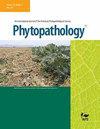Brandon G Roy, Gérard Demangeat, Sophie Meyer, Claude Gertz, Véronique Komar, Isabelle R Martin, Marc F Fuchs
求助PDF
{"title":"A Soilborne Virus Modifies the Root System Architecture of a Plant Host via a Single Amino Acid and Influences Nematode Transmission.","authors":"Brandon G Roy, Gérard Demangeat, Sophie Meyer, Claude Gertz, Véronique Komar, Isabelle R Martin, Marc F Fuchs","doi":"10.1094/PHYTO-03-25-0105-R","DOIUrl":null,"url":null,"abstract":"<p><p>Grapevine fanleaf virus (GFLV) is the main causative agent of fanleaf degeneration disease. Transmission of GFLV is exclusively accomplished by the ectoparasitic dagger nematode <i>Xiphinema index</i> in a noncirculative, nonpropagative mode. Previous studies of GFLV-host interactions revealed strain- and viral amino acid-specific changes to the root system architecture (RSA) in <i>Nicotiana benthamiana</i>. Here, a two-step assay first revealed the suitability of <i>N. benthamiana</i> in comparison with <i>Vitis</i> spp. for the transmission of GFLV by <i>X. index</i>. Then, a novel one-step assay revealed strain- and viral amino acid-specific differences in transmission between wild-type GFLV strains F13 and GHu and their respective mutants, with a single residue change to position 802 of the putative RNA-dependent RNA polymerase (protein 1E<sup>Pol*/Sd</sup>). Higher transmission rates were obtained with asymptomatic mutant GFLV-GHu 1E<sub>K802G</sub> (33.33%, 16/48) versus symptomatic wild-type GFLV-GHu (25.53%, 12/47) and with asymptomatic wild-type GFLV-F13 (75%, 30/40) versus symptomatic mutant GFLV-F13 1E<sub>G802K</sub> (51.28%, 20/39). These results indicate that <i>X. index</i>-mediated transmission is influenced by the GFLV strain and the identity of the amino acid in position 802 of protein 1E<sup>Pol*/Sd</sup>, with a glycine favoring transmission and a lysine reducing transmission. As expected, GFLV transmission was significantly correlated with differences in RSA traits, such as the number of root tips and total root length, but not with GFLV titer in <i>X. index</i> or in the roots of donor plants. This is the first report of a soilborne virus modifying both the RSA of a plant host and transmission by its dagger nematode via a single viral amino acid. [Formula: see text] Copyright © 2025 The Author(s). This is an open access article distributed under the CC BY-NC-ND 4.0 International license.</p>","PeriodicalId":20410,"journal":{"name":"Phytopathology","volume":" ","pages":"1223-1235"},"PeriodicalIF":3.1000,"publicationDate":"2025-09-01","publicationTypes":"Journal Article","fieldsOfStudy":null,"isOpenAccess":false,"openAccessPdf":"","citationCount":"0","resultStr":null,"platform":"Semanticscholar","paperid":null,"PeriodicalName":"Phytopathology","FirstCategoryId":"97","ListUrlMain":"https://doi.org/10.1094/PHYTO-03-25-0105-R","RegionNum":2,"RegionCategory":"农林科学","ArticlePicture":[],"TitleCN":null,"AbstractTextCN":null,"PMCID":null,"EPubDate":"2025/9/2 0:00:00","PubModel":"Epub","JCR":"Q2","JCRName":"PLANT SCIENCES","Score":null,"Total":0}
引用次数: 0
引用
批量引用
Abstract
Grapevine fanleaf virus (GFLV) is the main causative agent of fanleaf degeneration disease. Transmission of GFLV is exclusively accomplished by the ectoparasitic dagger nematode Xiphinema index in a noncirculative, nonpropagative mode. Previous studies of GFLV-host interactions revealed strain- and viral amino acid-specific changes to the root system architecture (RSA) in Nicotiana benthamiana . Here, a two-step assay first revealed the suitability of N. benthamiana in comparison with Vitis spp. for the transmission of GFLV by X. index . Then, a novel one-step assay revealed strain- and viral amino acid-specific differences in transmission between wild-type GFLV strains F13 and GHu and their respective mutants, with a single residue change to position 802 of the putative RNA-dependent RNA polymerase (protein 1EPol*/Sd ). Higher transmission rates were obtained with asymptomatic mutant GFLV-GHu 1EK802G (33.33%, 16/48) versus symptomatic wild-type GFLV-GHu (25.53%, 12/47) and with asymptomatic wild-type GFLV-F13 (75%, 30/40) versus symptomatic mutant GFLV-F13 1EG802K (51.28%, 20/39). These results indicate that X. index -mediated transmission is influenced by the GFLV strain and the identity of the amino acid in position 802 of protein 1EPol*/Sd , with a glycine favoring transmission and a lysine reducing transmission. As expected, GFLV transmission was significantly correlated with differences in RSA traits, such as the number of root tips and total root length, but not with GFLV titer in X. index or in the roots of donor plants. This is the first report of a soilborne virus modifying both the RSA of a plant host and transmission by its dagger nematode via a single viral amino acid. [Formula: see text] Copyright © 2025 The Author(s). This is an open access article distributed under the CC BY-NC-ND 4.0 International license.
一种土壤传播的病毒通过单个氨基酸修饰植物宿主的根系结构并影响线虫的传播。
葡萄扇叶病毒(GFLV)是葡萄扇叶变性病的主要病原体。GFLV的传播完全是由外寄生匕首线虫Xiphinema指数以非循环,非传播模式完成的。先前对gflv -宿主相互作用的研究揭示了菌株和病毒对烟叶根系结构(RSA)的氨基酸特异性改变。在这里,两步实验首先揭示了N. benthamiana比Vitis sp.更适合通过X. index传播GFLV。然后,一项新的一步实验揭示了野生型GFLV菌株F13和GHu及其各自的突变体之间的菌株和病毒氨基酸特异性传播差异,单个残基改变到假定的RNA依赖RNA聚合酶(蛋白1EPol*/Sd)的802位置。无症状突变型GFLV-GHu 1EK802G的传播率(33.33%,16/48)高于有症状野生型GFLV-GHu(25.53%, 12/47),无症状野生型GFLV-F13(75%, 30/40)高于有症状突变型GFLV-F13 1EG802K(51.28%, 20/39)。这些结果表明,X. index介导的传播受GFLV菌株和1EPol*/Sd蛋白802位氨基酸的特性的影响,其中甘氨酸有利于传播,赖氨酸降低传播。正如预期的那样,GFLV传播与根尖数和总根长等RSA性状的差异显著相关,而与x指数中的GFLV滴度或供体植株的根的GFLV滴度无关。这是首次报道一种土壤传播的病毒既可以修饰植物宿主的RSA,又可以通过其匕首线虫通过单个病毒氨基酸传播。
本文章由计算机程序翻译,如有差异,请以英文原文为准。

 求助内容:
求助内容: 应助结果提醒方式:
应助结果提醒方式:


